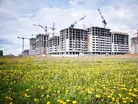Green means go: Sustainable construction is driving the industry forward

How sustainable construction sites are driving the industry forward. In collaboration with Shell Commercial Fuels, Construction Global hears from Mahesh Ramanujam, President and CEO of the U.S. Green Building Council.
Each year, the global construction industry uses three billion tonnes of materials. And worldwide, this sector is responsible for 23% of all CO2emissions. Little wonder then, that public and investor demand for green construction projects is growing.
Between 2018 and 2023, analysts predict that the green construction market will grow by 10.26% each year. Rising environmental awareness and measures are further pushing the sustainability of the building industry up today’s agenda.
But sustainability is not just about doing the right thing from an environmental perspective. It’s also about doing what’s profitable - and thus sustainable - from a commercial perspective. A report by Morgan Stanley found that projects constructed using certified-sustainable materials and project management techniques have lease-up rates 20% faster than average, while commanding a 3% rent premium. Moreover, the 2019 Edelman Trust Barometer - an annual trust and credibility survey -reported that 73% agree that companies can help improve society and the communities they operate in, while at the same time, increasing their profit margins.
However, while many construction companies take great pains to ensure that the materials they use, and the design of the construction project, meet the highest ‘green’ standards, the end-to-end sustainability of the site (or the construction process itself) is often overlooked.
Thus, the question arises: what can real-estate and infrastructure developers do to make their construction sites greener?
What Makes A Project Green?
“Did you know, a typical 134-hp bulldozer can emit the same amount of particulates as five modern cars?” Mahesh Ramanujam, the President and CEO of the U.S. Green Building Council, animatedly explains the pitfalls of not taking care of site sustainability. “So, you’ve got companies that aren’t sure of the value of green construction, but at the same time their guys on the site are just choking.”
Ramanujam has dedicated his professional life to the advancement of Leadership in Energy and Environmental Design (LEED), a sustainable construction certification which, among other things, teaches construction professionals how to apply sustainable design and building standards consistently across different sites and projects.
“We help developers take the first step to becoming sustainable,” he explains. “My motto is, what gets measured, gets done. What gets done, gets improved. What gets improved, gets replicated. What gets replicated, transforms the market. That’s why standards are so important.”
Asked what advice he’d give to project managers looking to improve their sustainability, Ramanujam hones in on three things in particular. The first is knowing your inventory. Know the spec of every piece of material or machinery you use and regularly measure to make sure it’s performing to its full potential. Next, create a construction plan with sustainability built in and then monitor, so you know how closely you are sticking to that plan. Thirdly, look to the sustainability of the site itself, for instance, by choosing fuels and other consumables that meet the highest standards of sustainability.
By doing these things, you create the framework necessary to develop - and keep in focus -a holistic view of the construction project: one that takes in everything, from initial concept and design, right through to final completion.
On-site Fuel Considerations
A key - and often overlooked -factor is the importance of properly maintained equipment and fuel efficiency. According to research by Shell, 40% of construction companies say they had not previously considered the role of fuel in determining a project’s total cost of ownership (TCO). A further 44% admitted that inappropriate fuel selection had contributed to unplanned downtime.
Switching to a fuel with active deposit control technology -additives designed to clean up the engine from carbon deposits- can increase equipment efficiency and ultimately reduce running costs and overall TCO, to help unlock funds for greater fleet efficiency, including asset upgrades.
And that’s not the only benefit of using premium fuels. Preventing the build-up of deposits on fuel injectors and other key fuel system components keeps the engine running at peak efficiency. This maximises the output of each unit of equipment, which in turn reduces the amount of overall fuel required, helping to cut CO2 and, in engines up to Euro III, also black smoke.
Shell’s survey found that 57% of construction managers were looking for ways to cut fuel consumption; while at the same time, the industry is under increasing pressure to cut emissions. The right premium fuel can help achieve both.
Read the latest issue of Construction Global here

The Growth Of Green Construction
Where is green construction best developed? “I don’t really see a difference between the West and the rest,” replies Ramanujam. “The real difference is between the leaders and everyone else. And often the leaders are to be found in the developing world, particularly in Asia.”
Already by 2016, 40% of all construction projects in Asia were built to sustainable standards. In some countries, this figure is significantly higher. In Singapore, for instance, 60% of all projects are now classed as sustainable. Nor is Asia the only part of the developing world that is taking a lead in the move to sustainable practices. Africa, in particular South Africa, is also driving its construction sector hard to set best practices. By 2018, 61% of its building projects were classed as green.
“The companies driving these changes are the ones who deliver best practice today and will deliver the next practice that we use tomorrow,” says Ramanujam. He reminds us that construction activity accounts for 36% of worldwide energy. In fact, were the construction materials sector a country, it would be the third-largest emitter of greenhouse gas emissions, behind only the US and China. As such, any actual country that is serious about reducing its emissions, must be serious about making its construction sector sustainable.
Partnership Is The New Leadership
“Partnership is the new leadership,” Ramanujam explains. “Companies that collaborate across the value chain not only bring in new expertise that they could not economically have developed in-house, but they also spread knowledge and best practice throughout the industry and along their supply chains.”
This makes it even more important that developers work with energy experts such as Shell, who can help them choose the right fuel and energy option for each use case and vehicle, in addition to helping develop data-driven and sustainable models of fuel selection, storage and usage, which will ultimately foster future sustainably and cost efficiency.
Bridging The Knowledge Gap
“If there’s one thing we have to do, it’s bridge the knowledge gap,” says Ramanujam. “We have to spread the understanding of sustainability best practice, so it becomes the default in the industry.”
The good news is that, as the figures show, the momentum for this change is already gathering pace. For the companies that are willing to embrace change, this means higher profitability, better working environments and easier access to investment funds - all important factors to stay competitive and ahead of the curve in the construction industry.
- Could Self-Healing Concrete Reshape Global Construction?Construction Projects
- ABB's Role in Vulcan Energy's Bold Construction ProjectSustainability & Green Building
- Scania's Sleipner: Built for Construction and MiningSustainability & Green Building
- e-Dutra: Lowering Financial Risk of Charging infrastructureSustainability & Green Building



